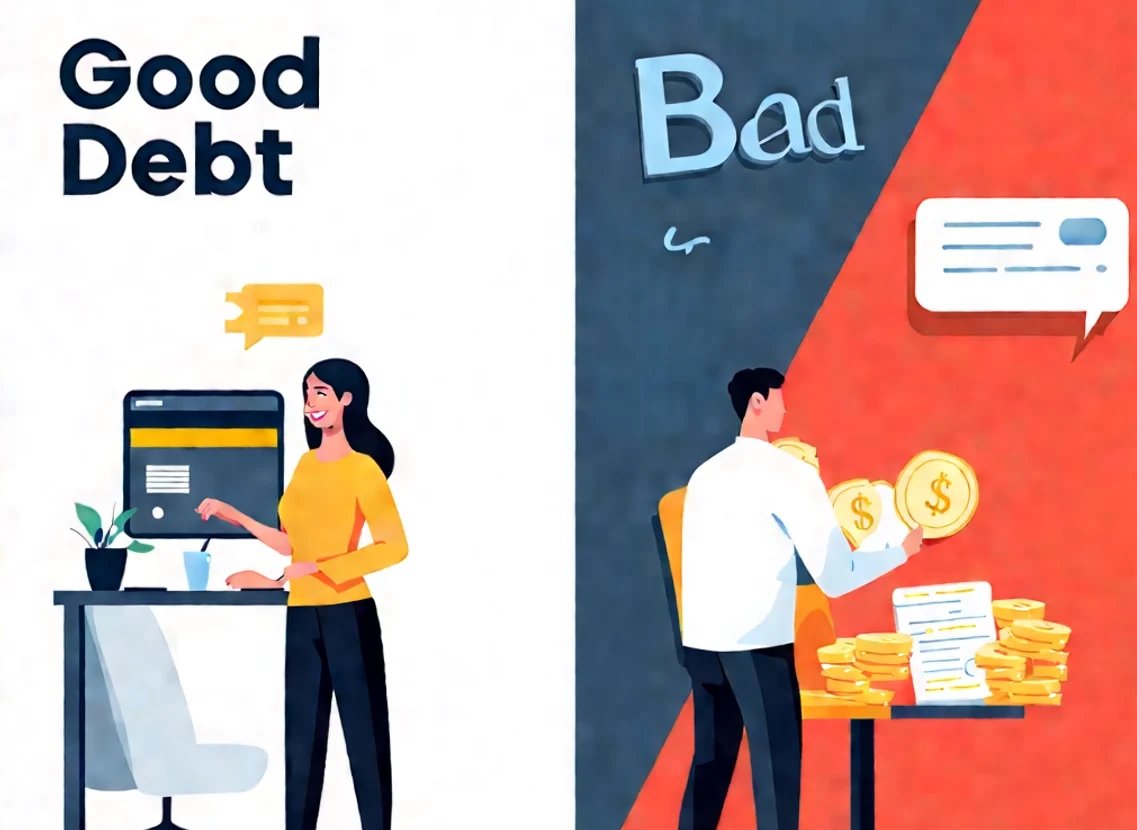Good Debt vs. Bad Debt: A Guide to Smart Borrowing
Debt often carries a negative image, but it’s important to understand that not all debt is bad. The impact of debt varies based on how it’s used and managed. For some, debt can be beneficial, while for others, it may lead to financial challenges. In this blog post, we’ll explore the differences between good debt and bad debt to help you make informed financial choices that align with your personal goals.

What Is Debt?
Debt is essentially borrowing money with a promise to repay it, usually with added interest. While it’s true that borrowing should be approached cautiously, debt can be either beneficial or detrimental depending on how it’s utilized. For instance, if you borrow money to invest in something that generates income or increases in value, it can be a tool for growth. Conversely, debt taken for luxury or depreciating items often results in financial strain.
Types of Loans in India
Before diving into what constitutes good or bad debt, let’s review some common loan types in India:
- Business Loan
- Home Loan
- Personal Loan
- Credit Card Loan
- Education Loan
- Car Loan
Each loan type serves a distinct purpose, but its impact on your financial health depends on how you use it.
Understanding Good Debt
Good debt is an investment in your future. It contributes positively to your finances by either increasing your income or boosting your net worth. Here are some examples:
1. Education Loan
Investing in education often pays off over time by increasing earning potential. Whether you’re pursuing higher education or skill-building courses, the long-term benefits can outweigh the initial cost.
2. Business Loan
Taking a loan to expand or start a business can yield significant returns if planned properly. A well-invested business loan can generate consistent income and help you achieve financial independence.
3. Real Estate Loan (Mortgage Loan)
Investing in real estate is usually considered good debt. Properties generally appreciate over time, and rental income can offset loan repayments. However, this holds true primarily when the property is bought for investment, not for personal luxury.
Identifying Bad Debt
Bad debt, on the other hand, negatively impacts your financial health. It often involves borrowing for things that depreciate in value or don’t contribute to income generation. Here are some examples:
1. Credit Card Debt
Using credit cards for luxury expenses or maintaining a high balance without timely repayment can lead to financial trouble. High interest rates and penalties can quickly spiral into unmanageable debt.
2. Personal Loan for Non-Essential Expenses
Taking personal loans to fund vacations, weddings, or other non-essential expenses can strain your finances. If the borrowed money doesn’t generate returns, it becomes a liability.
3. Car Loan for Personal Use
Cars are depreciating assets. While they are often necessary, taking a loan to buy an expensive vehicle for personal use can result in financial loss. However, if the car generates income, such as being used for ride-sharing services, it may qualify as good debt.
Factors to Consider Before Taking a Loan
To ensure your debt is a stepping stone and not a stumbling block, consider the following factors before borrowing:
1. Purpose of the Loan
Ask yourself whether the loan will help you generate income or grow your wealth. If not, reconsider.
2. Interest Rates
Always compare interest rates to find the best deal. Lower interest rates can significantly reduce the cost of borrowing.
3. Repayment Capacity
Evaluate your financial stability and repayment capacity before committing to a loan. Avoid borrowing beyond your means.
4. Alternatives to Borrowing
Explore other options, such as saving up for the purchase or finding additional income sources, before resorting to a loan.
How to Maximize the Benefits of Good Debt
To ensure you’re leveraging good debt effectively, follow these strategies:
Plan Your Investments
Ensure that the borrowed money is invested in assets or ventures with the potential to generate higher returns than the loan’s interest rate.Maintain a Budget
Track your expenses and repayments to avoid financial strain. A clear budget can help you stay on top of your obligations.Pay on Time
Timely repayment not only helps you avoid penalties but also improves your credit score, making it easier to secure favorable loans in the future.Avoid Over-Borrowing
Even good debt can become bad if you overextend yourself. Borrow only what you need and can repay comfortably.
Conclusion: The Path to Financial Freedom
Debt, when used wisely, can be a powerful tool to achieve your financial goals. Understanding the difference between good and bad debt is essential for making informed decisions. Good debt can lead to wealth accumulation and financial stability, while bad debt can hinder your financial progress. Always assess the purpose of the debt, your ability to repay it, and its long-term impact on your financial health before making borrowing decisions.

